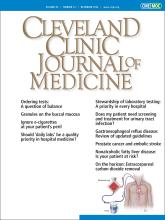In their commentary in this issue, Drs. Murphy and Schram1 state correctly that the overall impact on cost and blood savings from eliminating unnecessary complete blood cell counts (CBCs) and serum electrolyte panels (SEPs) in hospital inpatients is likely to be insignificant over a short hospital stay. The tests are low-cost, and the total aggregate blood volume is also low. And as they note, benefits of reducing daily laboratory tests on patient experience have not been robustly reported in the literature.
See related article, page 685
OTHER CONSIDERATIONS
There are other important considerations in this analysis, however, including indirect costs, downstream testing or other workup based on minor abnormalities uncovered during daily testing, patient-care settings other than hospital medicine, and shortages in staff and supplies. Cumulative savings have been documented in several hospital settings—up to $2 million annually at a single center.2
Daily CBCs, SEPs, and coagulation panels are often ordered to monitor general health in the inpatient setting. But minor test abnormalities without clinical findings may lead to additional testing, including more extensive laboratory workup or additional imaging studies. For example, a creatinine elevation above baseline may lead to urine studies, renal ultrasonography, and perhaps even a request for a nephrology consult. In these situations, some may opt to follow a test until it normalizes despite the absence of signs or symptoms, which can lead to additional waste. Data also show that reduced testing does not lead to missed diagnoses or increased readmissions.2–4
Drs. Murphy and Schram maintain that the impact of fewer blood draws on patient experience and the need to reduce phlebotomy visits are not well studied. Subjectively, anyone who has been an inpatient would attest that any needle sticks avoided are welcome in terms of both discomfort and sleep disruption. Further, sleep disruption may have additional downstream effects, such as increased risk of delirium. Although patients may undergo early-morning phlebotomy for additional nondaily testing, many healthcare systems have instituted processes to add on testing to blood that was drawn previously and is stored in the laboratory.
WASTE WITH BLOOD DRAWS
In the critical care setting, blood is frequently obtained from existing intravenous (IV) lines with significant waste in the blood draw process. Koch et al5 showed that cardiac surgery patients lose 1 to 2 units of blood to phlebotomy during their hospital stay, mostly due to discard volume (approximately 75%) from the blood draw itself. This adds up, especially when there are blood product shortages. In a hospital medicine patient, blood draws can be performed by a phlebotomist rather than drawn from an existing IV line.
We acknowledge the potential benefit of laboratory technologist and phlebotomist time-savings if both CBCs and SEPs are reduced concomitantly. In fact, this could shift time to other areas of need or even reduce the number of phlebotomists required for morning labs. It could also reduce the burden on bedside nursing staff who may take on these tasks. The need to optimize efficiency of these teams is even more acute in the current labor market. Savings also include conservation of blood collection tubes, which is relevant because of recent supply chain disruptions.6
The impact of targeting just daily CBCs and SEPs may be a small contributor to alleviating healthcare direct costs and waste. But stewardship efforts on these tests, which can be considered low-hanging fruit, can lead to discussion of how to address more costly tests, as well as how to avoid shotgun approaches to testing for broad differential diagnoses.
DISCLOSURES
The authors report no relevant financial relationships which, in the context of their contributions, could be perceived as a potential conflict of interest.
- Copyright © 2022 The Cleveland Clinic Foundation. All Rights Reserved.









